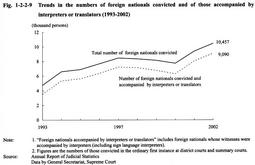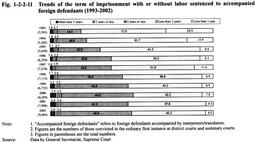| Previous Next Index Image Index Year Selection | |
|
|
4 Treatment of foreign offenders (disposition by courts) (1) Outline of the trends of foreign nationals in criminal cases Fig. 1-2-2-9 shows the trends in the number of foreign nationals who stood as defendants and were convicted in the ordinary first instance and the number of such foreign nationals who were accompanied by interpreters or translators. The foreign nationals convicted slightly declined from 1998 to 2000 but started to increase again in 2001, showing an overall upward trend. In 2002, 10,457 foreign nationals were convicted and 9,090 were accompanied by interpreters or translators, both numbers marking record highs. The rate of foreign nationals convicted to all persons convicted was 12.2% (Source: Annual Report of Judicial Statistics, Data by General Secretariat, Supreme Court).
Fig. 1-2-2-9 Trends in the numbers of foreign nationals convicted and of those accompanied by interpreters or translators (1993-2002) In 2002, 9,130 defendants who were foreign nationals (foreign defendants) were accompanied by interpreters/translators and finally disposed in the ordinary first instance, and a total of 35 languages were used for interpretation/translation. By language, Chinese was used most frequently for 3,463 persons (37.9%), followed by Korean for 1,195 persons (13.1%), Tagalog for 712 persons (7.8%), Spanish for 579 persons (6.3%0), Thai for 560 persons (6.1 %), Portuguese for 490 persons (5.4%), and Persian for 465 persons (5.1 %). The rank order of the top 3 languages has been the same since 1998 (Source: Data by General Secretariat, Supreme Court).(2) Sentencing Table 1-2-2-10 shows the sentences (excluding sentences to fine) handed down to foreign defendants accompanied by interpreters/translators (accompanied foreign defendants) in the ordinary first instance in 2002, by type of major offense. The suspended execution rate among accompanied foreign defendants was 84.1%, much higher than that among Japanese defendants convicted in 2000 (59.9%), because those convicted of Immigration Control Law violations accounted for more than 60% of accompanied foreign defendants, and the suspended execution rate for them was extremely high (96.6%). The suspended execution rate for accompanied foreign defendants excluding those convicted of Immigration Control Law violations was 63.5%.
Table 1-2-2-10 Sentences handed down to accompanied foreign defendants, by type of major offense (2002) Fig. 1-2-2-11 shows the trends of the term of imprisonment with or without labor sentenced to accompanied foreign defendants in the ordinary first instance over the last 10 years. During this decade, the share of those sentenced to imprisonment for less than 1 year has declined whereas the share of those sentenced to imprisonment for 2 years or more but not more than 3 years has clearly risen, which indicates that the term of imprisonment sentenced to accompanied foreign defendants has generally become longer.Fig. 1-2-2-11 Trends of the term of imprisonment with or without labor sentenced to accompanied foreign defendants (1993-2002) |


